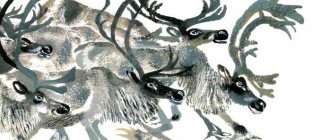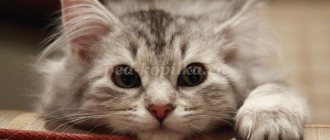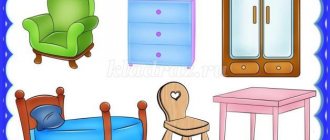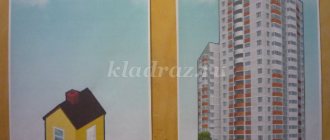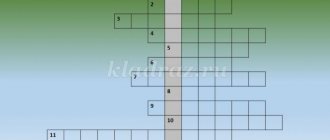Abstract of OOD (Cognition - FCCM) in the senior group “The World Around Us”
Abstract of GCD (Cognition - FCCM) in the senior group “The World Around Us”Target:
Introduce the concept of “nature”
,
“living nature”
,
“inanimate nature”
.
Tasks:
Educational objectives:
- Create conditions for children’s research activity, the formation of basic knowledge and concepts about natural phenomena;
- Nature is everything that surrounds us, but is not made by human hands.
- Teach children to correctly answer the teacher’s questions based on subject pictures, develop speech through artistic expression.
- To teach to distinguish and select objects of living and inanimate nature, to bring to the concept "nature"
.
- To introduce and generalize children's knowledge about living and inanimate nature.
Developmental tasks:
- Develop intellectual abilities, imagination, creativity, elements of logical thinking, memory.
Educational tasks:
- To cultivate a cognitive interest in the world around us, a desire to preserve and care for it, to cultivate an understanding of the relationships between living and inanimate nature.
Main educational area: cognition (FCCM)
Integrative areas:
- Socialization
- Musical
- Artistic creativity
- Health
- Safety
Methods and techniques:
Methods:
- search, visual, verbal, practical, game.
Techniques:
- Literary word, didactic games, questions, encouragement.
Material for the lesson:
Handout:
- story pictures about nature for each child.
Demo material:
- Images,
- Slides,
- Model of a volcano.
Technical training aids
- Multimedia equipment: screen, projector, flash drive with recorded music. works, slides
Equipment:
napkins, skull cap models, tables, magnets, magnetic boards, courtyard and house models, artificial snow.
Vocabulary work:
- Enrichment of vocabulary: volcano, lava, magma, eruption.
Preliminary work:
Preparation and production of visual demonstration material, selection of experiments, development of didactic games, preparation of handouts, selection of slides and music.
Organizing time.
Educator:
Hello guys!
“Look, my dear friend, what is around, the sky is blue, the sun is shining golden,
The wind plays with leaves A cloud floats in the sky Field, river and grass Mountains, air and foliage,
Birds, animals and forests, Thunder, fog and dew Man and the season - It's all around...
Children's answers: Nature.
— Guys, are you familiar with the word nature, what does it mean? (children's answers)
(Slide No. 1)
- The entire nature of the Earth can be divided into two huge worlds: the world of living nature and the world of inanimate nature.
- What is the world of living nature? – (these are plants, animals, insects, birds, fish)
.
— Wildlife is (Slide No. 2)
everything that grows, breathes, eats, develops.
Inanimate nature is everything that does not breathe, does not grow, does not develop. This is everything that surrounds us - the moon, sun, mountains, water, stones, air, etc.
-Do you think humans and all living organisms can live without inanimate nature? Why? (children's answers)
— That’s right, neither humans nor all living organisms can live without air, without water, without sun, without food. (Slide No. 3)
To become nature's friend, find out all its secrets, solve all its riddles, learn to observe,
Let's develop attentiveness together, and our curiosity will help us find out everything.
— Today we will talk in more detail about some objects of inanimate nature. I will ask riddles, and you try to guess them.
Riddles and slides
1. -Well, which of you will answer: It’s not a fire, but it burns painfully, It’s not a lantern, but it shines brightly, And it’s not a baker, but it bakes. (Sun)
(Slide No. 4)
-The sun is a bright star, it appears every day at dawn, and disappears in the evening after sunset.
2. - Adults and children know
That it is not the sun that shines at night.
Chubby and pale,
She is always among the stars.
-The Moon is a satellite of the Earth, it is as round as our planet, only much smaller in size. (Slide No. 5)
3. Fluffy cotton wool is floating somewhere. The lower the cotton wool, the closer the rain. (Clouds)
(Slide No. 6 and 7)
-This is a collection of tiny droplets of water or tiny pieces of ice, depending on the time of year. There is always water vapor in the air. Water constantly, at any temperature, evaporates from the surface of reservoirs, soil, leaves and stems of plants, rises, and thus clouds appear in the sky.
4. -The field, forest and meadow are wet, the city, the house and everything around! He is the leader of clouds and clouds, You know, this is - (Rain)
(Slide No. 8)
- When a lot of water accumulates in the clouds, they become dark, heavy and turn into what? (clouds)
, as if they were hanging over us and then what begins? You can hide from the rain under any canopy and roof or under an umbrella
5. — For a moment, the Multi-colored miracle bridge grew into the ground. The miracle master made a high bridge without railings. (Slide No. 9)
— After heavy rain or thunderstorms, you can sometimes see a rainbow. This is an optical phenomenon in nature where bright sunlight is broken up into several different colors. Which ones? (red, orange, yellow, green, blue, indigo, violet)
.
Physical exercise.
Get up quickly, smile, Stretch higher, higher. Well, straighten your shoulders. Raise, lower.
They turned to the left, to the right, Touched their feet with their hands. They sat down and stood up, they sat down and stood up and ran on the spot.
Game "Living - Nonliving" :
There are pictures on the table, help me separate them. Place objects with living nature on one easel, and inanimate nature on the other. (children arrange and explain: living nature is what moves, grows, develops, dies and reproduces; inanimate; if not nature, then why do they think so, because it is made by human hands.)
“And now I want to ask you another riddle:
The mountain woke up from its sleep, began to seethe and boil. And a lot of smoke, soot, and ash rose up from the cap.
The lava flows like honey, thick.
What should you call this mountain? (Volcano)
(Slide No. 10)
- It represents a mountain (Slide No. 11)
, in the upper part of which there is a depression - called a volcanic crater. In the very thickness of the mountain there is a channel, it is called a vent. It leads to a special underground cave - a source of magma. Magma is a molten, very hot substance.
A model of the volcano is brought in.
— Do you want to see a volcanic eruption? Let's try to do this.
During the experiment I read the poem:
Not a mountain, but a giant - a Fire-breathing volcano! He spews out lava that burns the mountainside,
Spews out stones, gases, - The skies immediately darken. Ashes, poisonous smoke rise above him.
An underground roar is heard, as if a giant has fallen asleep, and is snoring and dreaming, how great and terrible it is.
— Guys, there are different mountains, look at the picture. There is something white on the top of this mountain, what do you think it is? (Snow)
“It’s snow, and since the mountains are very high and it’s very cold there, the snow doesn’t melt.”
- Guys, do you know what snow is made of? (from snowflakes)
(Slide No. 12)
- How are snowflakes formed? (children's answers)
They used to think that snow was frozen droplets of water. But that's not true. Scientists have unraveled the mystery of the birth of snowflakes. Snowflakes are formed from water vapor that rises very high above the ground, where eternal cold reigns. Tiny pieces of ice - crystals - are first formed from water vapor. These are not snowflakes falling to the ground yet, they are still very small. This crystal grows all the time and turns into a snowflake. (Slide No. 13)
— Guys, what time of year is it now? (Winter)
— Do you like winter, playing with snow?
— What can you make out of snow outside, what games can you play? (Slide No. 14)
— Is it possible to play with snow in a group? Why? (melts)
- I want to invite you to play with magic snow, which will not melt not in the group, not in your hands.
2 layouts of the yard are brought in, the children are divided into 2 subgroups.
-Look, this is a small courtyard with houses, a park, and trees. I suggest you decorate the playground with snow buildings.
The children are working.
There is a huge house on earth under a blue roof, the sun, rain and thunder, forest and sea surf live in it.
Birds and flowers live in it, the cheerful ringing of the stream. You live in that bright house and all your friends.
Wherever the roads lead, you will always be there. This house is called the nature of our native land.
Lesson analysis.
Abstract of GCD on FCCM for children of the senior group on the topic: Types of transport
Abstract of the GCD for children of the senior group, developed in the technology of the activity method “Situation” according to the Federal Center for Competitive
Education Educational area : “Cognitive development” Educator: Stolyarova Natalya Aleksandrovna. Topic : Types of transport. Goal: Formation of children's ideas about types of transport: air, land, water. Objectives: 1. Reveal the importance of transport for people. 2. Summarize and systematize children’s ideas about human movement. 3. Establish rules of conduct in public transport and at bus stops. 4. Train mental operations: analysis, comparison, generalization and analogy. 5. Develop students’ logical thinking, attention, and memory. Materials: cards with images of transport, map, green, red and yellow flags. Progress of the educational situation. 1. Introduction to the situation.
Didactic tasks: motivate children to engage in gaming activities.
The teacher gathers the children around him. — Do you like to travel? — Which of you vacationed this summer and where? - How did you get there? On what? The teacher says that Dunno also wanted to go on a trip to the moon. But he doesn’t know how to get there from his flower city. - Do you want to help him? - Can you do this? “Then let’s go to Dunno in his Flower City.” 2. Updating knowledge.
Didactic tasks: to update children’s knowledge of the names of transport, why it is needed, how to use it, the components of transport.
Children approach the table on which there are cards with pictures of transport. — Cards with images of transport are laid out on the table. -What lies in front of you? (children list the names of transport: car, train, plane, bicycle, boat, balloon, etc.) - How can you call it in one word? (transport) The teacher praises the children and creates a situation of success. 3. Difficulty in a game situation. Didactic objectives: 1. Create a motivational situation for the formation of children’s ideas about types of transport; 2. To form experience, under the guidance of a teacher, of fixing the difficulty and understanding its cause. The teacher offers to choose the transport that Dunno will need for the trip. And he clarifies that you need to choose three types of transport. As a rule, children are lost and do not know what to choose. — Were you able to choose? - No - Why couldn’t they? — We don’t know the types of transport. - So what do we need to know? - Types of transport. 4. Discovery of new knowledge. Didactic objectives: 1. To form in children an idea of types of transport; 2. To form the experience of independent discovery and emotional experience of the joy of discovery. Children approach the table on which there is a map. The map shows: a flower city, land, sea, and destination - the moon. — How can Dunno get to the moon? - How will he travel from the flower city to the sea? (by car, by train, by bicycle) - What will it sail across the sea? (on a ship, boat, steamer) - How will he get to the moon? (on a rocket, on a plane, on a helicopter) The teacher praises the children. - But we only need to choose three types of transport, and to find out we need to solve riddles. - Can you? The teacher sits the children on the carpet and turns on a presentation about types of transport. 1 slide. Doesn't fly, doesn't buzz, the beetle runs down the street. And two brilliant lights burn in the beetle’s eyes. Car - So, what will Dunno drive first? (by car) - On what surface does the car move? (on the ground) - So what type of transport is this? (ground) - What is a ground mode of transport? (these are cars that transport people and goods on land) - What else applies to ground transport? (bus, bicycle, taxi, truck, etc.) 2 slide. It swims bravely through the waves, without slowing down, only the car’s hum is important. What's happened? Steamboat - What will it go on next? (on a steamboat) - On what surface does the steamboat move? (by water) - What type of transport is a steamship? (to water transport) - What else applies to water transport? (ship, boat, motor ship, yacht, etc.) 3 slide. She always flies between the stars, She doesn’t need warmth and light. The answer to the riddle is very simple: After all, this is a fast... ( rocket ) - How will it get to the moon? (on a rocket) - What does the rocket move on? (by air) - What type of transport is the rocket? (to air) - What else applies to air transport? (plane, helicopter, etc.) - Well done! - So what types of transport can Dunno use to get to the moon? (by car, steamship and rocket) - What types of transport did you become familiar with? (land, water and air). The teacher says that Dunno thanks them for their help and goes to the moon. — You were able to send Dunno to the moon because you know what types of transport transport is divided into. 5. Incorporation of new knowledge into the knowledge system. Didactic objectives: 1. To consolidate the idea of types of transport; 2. Organize active recreation for children. Outdoor game “Traffic Light” Children become a chain one after another. At the teacher’s signal (“Start the engines! R-rr-r-r-r”), the children begin to move, and the teacher controls the movement by raising a flag of the appropriate color - red - stop, yellow - moving in place, or green - moving. Game “Sort out transport by type” Cards are laid out on the table, the teacher divides the children into three subgroups: the first subgroup collects land transport, the second – water transport, the third – air transport. 6. Summary of the lesson. Didactic tasks : to restore in the children’s memory what they did and create a situation of success. Children gather around the teacher. - Who did you help today? - How did you help? — What knowledge helped us send Dunno to the Moon?
We recommend watching:
Summary of GCD for introducing older preschoolers to the work of the poet Fet Summary of plot-based GCD in physical education for children of the senior group Summary of GCD in the senior group of compensatory orientation GCD in kindergarten for older preschoolers
Similar articles:
Summary of GCD in the senior group on the topic “Communication”
Summary of GCD in the senior group of kindergarten on the topic “Relaxation”
Summary of a lesson on cognition in the senior group on the topic “Dairy products”
Summary of a lesson on cognition in the senior group on the topic “Construction professions”
Abstract of educational activities for cognition in the senior group of kindergarten on the topic “Russian folk crafts”
